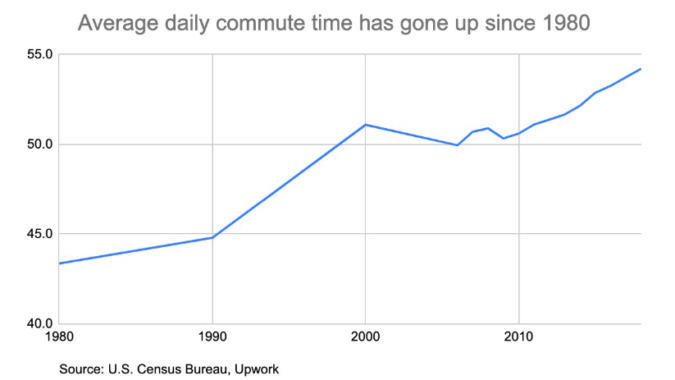By Adam Ozimek
Chief Economist at Upwork
As businesses consider reopening offices, many Americans are thinking about what work was like before COVID and, more specifically, how long it took them to get there.
One of the most significant benefits of remote work is the lack of a commute. From both a timesaving and productivity standpoint, a lack of commute can improve a person’s overall happiness and work-life balance.1
But how much time can remote work actually save? And where do workers who can go remote stand to benefit most by going remote? Through this analysis, we explore these questions and find that the potential commuting benefits of remote work are significant across the U.S. Illustrating the potential for these gains, we find that since the onset of COVID-19, the economic benefit of remote work from lower commutes has been $90 billion.
Impacts of Remote Work on Commute Times
To understand the potential gains, it’s important to quantify the economic burden commuting currently places on Americans. In 2018, the average person spent 54.2 minutes commuting each day.2 This translates to 4.6 hours a week, 18.4 hours a month, and 9.5 full days a year commuting. And commutes are only getting longer; compared to 1980, the average daily commute has increased by almost 11 minutes a day, which translates to two full days a year. This loss of time has a tremendous cost on household pocketbooks, quality of life, and on the environment.
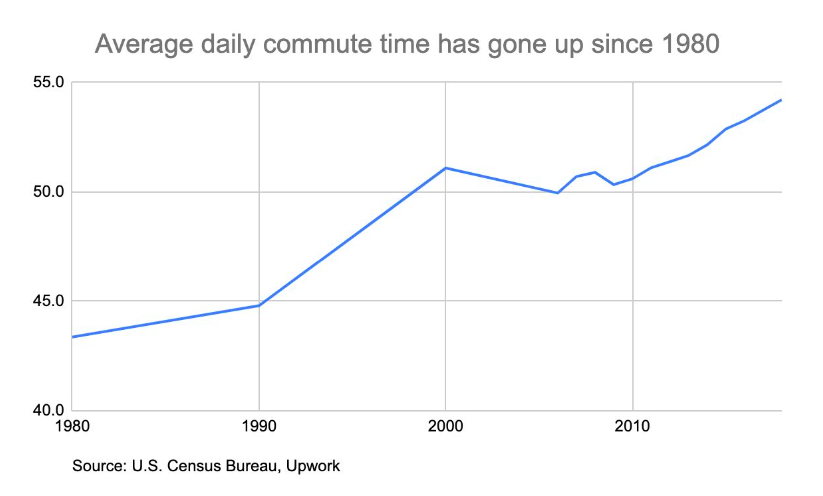
Since the onset of COVID-19 and the massive shift to remote work, however, many are considering life without a commute. To understand the impact of remote work on commutes, we surveyed 1,000 people currently working from home to see how much time they are saving sans commute. Of this group, 31.4% are working from home due to COVID and 15% were working from home prior to COVID.3
To estimate time savings, we asked how long their commute was at the last job that they commuted to. Using this data, we found that on average, those who are working remotely due to COVID save an average of 49.6 minutes a day. This means that since the onset of COVID in mid-March, people have saved more than 4 days (4.13) from commuting.4 And for those who were already working remotely before COVID, they save on average 51 minutes a day by working remotely.
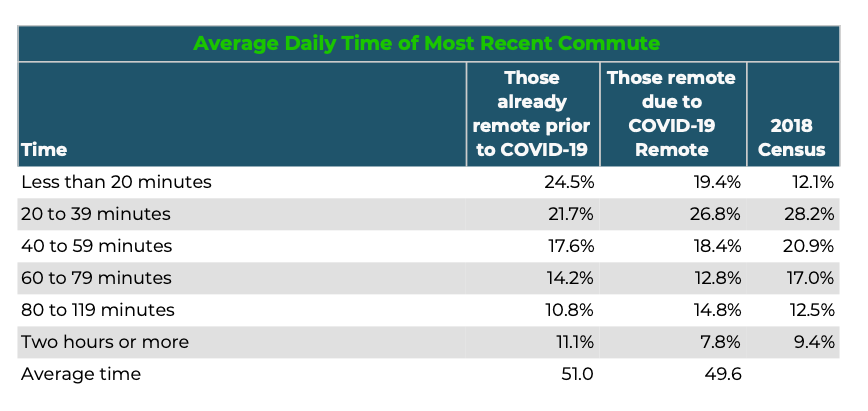
Impacts of Remote Work on Costs and Transportation
In addition to time, the survey data reveals that the shift to remote work has also been beneficial for both people’s wallets and in reducing their carbon footprints. Of the COVID remote workers, 86% report having previously commuted by car and are now saving, on average, 46.3 minutes per day. Altogether, we estimate that those post-COVID remote workers are saving 32.9 million hours of car commuting per day.5
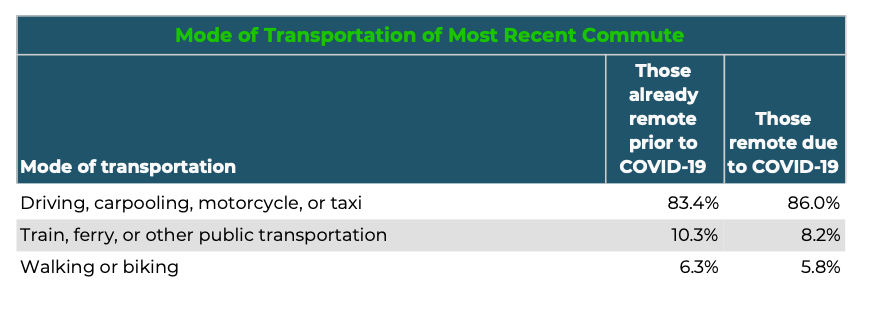
This saving in commute time implies 890 million fewer miles traveled each day.6 Using an average operating cost for fuel, maintenance, and repairs of 20.54 cents per mile, this translates to $183 million per day in direct commuting costs.7
However, these costs to the commuter do not include the cost to others from lost life and property from accidents, the environmental cost of pollution, or congestion costs. Economists estimate an externality cost per mile of 18.38 cents per mile, for an externality cost savings of $164 million per day.8
Finally, we can also put an economic value on the time savings. A standard cost benefit assumption is to value savings from less time spent driving at $12.50 per hour, which aggregates to $411 million every day.9
Altogether, $758 million is being saved per day by post-COVID remote workers who used to drive for their commute, a cumulative savings of over $90 billion since the onset of the pandemic. To put this into perspective, commuters who were commuting by car prior to the pandemic have saved over $2,000 each since mid-March, including the costs to the public from their driving. Although large, these savings do not even include the benefits from those who commuted via other modes or from the additional 16.9 million saved car commuting hours a day from those who were remote before COVID.

Which Cities Stand to Gain the Most from Remote Work
Although people everywhere can benefit from a lack of commute, we also wanted to explore the geography of remote work benefits. To see where people stand to benefit the most from remote work, using American Community Survey Data we analyzed the average commute length for people in occupations that can potentially be done remotely by each metro.10 We then ranked 261 metro areas by average commute time for workers who could potentially go remote to find the Top 25 Cities Where Workers Benefit Most from Going Remote.11
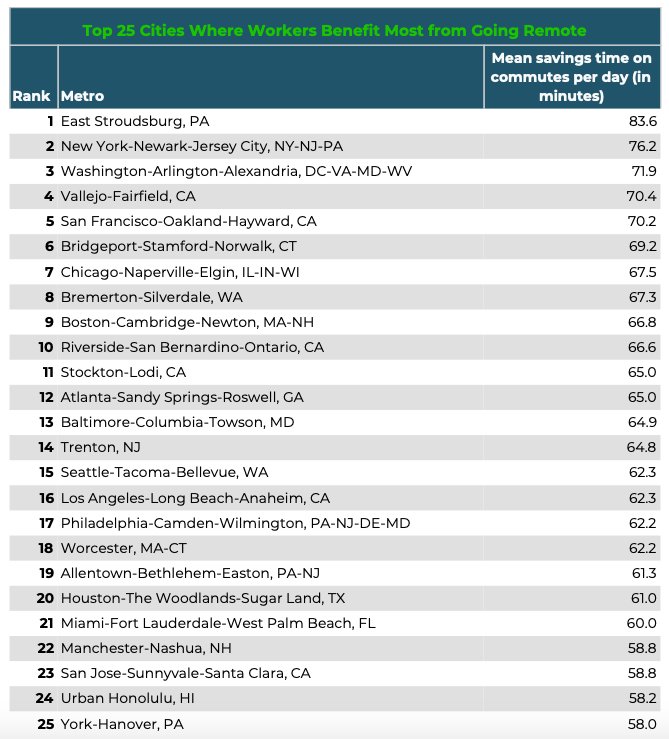
To see the full rank of metros, click here.
What we find in the ranking, is workers living in the biggest cities around the U.S. stand would find the biggest commuting benefits. These areas tend to have desirable labor markets in the large, dense, cities at their cores, which makes individuals willing to pay a high cost of commuting to access them.
We see this, specifically, when looking at the Top 15 most expensive areas, as identified in the Upwork report “When Work Goes Remote,” which was released in June 2020. In nine of these top metros, the average commute for someone in an occupation that can be done remotely is over an hour per day. Most notably, the New York, San Francisco, and Washington metros average commute times of over 70 minutes.
Potential remote workers in bedroom commuter towns, like East Stroudsburg, PA, also stand to gain a lot from remote work. In East Stroudsburg, workers spend an average of 77.1 minutes a day commuting, likely to New York City, which adds up to 320 hours, or 13 full days.
Regardless of the metro area, the lack of a commute is undoubtedly viewed by many as a top benefit of remote work. Professionals have more freedom and flexibility in their schedules, while also having more time to spend outside of work. In addition to workers, businesses who embrace remote work may also find increased productivity as professionals shed the time and stress of extensive commutes.
________________________
1 https://hbr.org/2017/05/reclaim-your-commute
2 Commute times in this report are based on round trip estimates.
3 These results are consistent with estimates from Brynjolfsson, E., Horton, J. J., Ozimek, A., Rock, D., Sharma, G., & TuYe, H. Y. (2020). Covid-19 and remote work: An early look at US data (No. w27344). National Bureau of Economic Research.
4 Calculated based on 5 days of work for 24 weeks (120 days). Assuming shelter in place orders began March 16th, 2020
5 This estimate utilizes the 157 million employment level average from 2019, and assumes that those who did not have previous commutes would save as much on average as those who did.
6 This average miles per hour is 27.08 for private vehicle travel from the NHTS. https://nhts.ornl.gov/assets/2017_nhts_summary_travel_trends.pdf
7 https://exchange.aaa.com/wp-content/uploads/2019/09/AAA-Your-Driving-Costs-2019.pdf
8 Langer, Ashley, Vikram Maheshri, and Clifford Winston. “From gallons to miles: A disaggregate analysis of automobile travel and externality taxes.” Journal of public Economics 152 (2017): 34-46.
9 https://www.transportation.gov/sites/dot.gov/files/docs/2015%20Revised%20Value%20of%20Travel%20Time%20Guidance.pdf
10 We utilize occupational codings from Dingel, J. I., & Neiman, B. (2020). How many jobs can be done at home? (No. w26948). National Bureau of Economic Research.
11 These are the metro areas for which American Community Survey microdata are available. Travel times are for averages for those with some commute.
